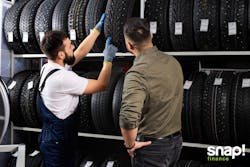The Near and Long-Term Future of Automotive Service Financing
When addressing the future of automotive service financing, including the purchase of tires, we should place the future in two buckets: near-term and long-term. It’s the only fair way to address the concept, as the two future states are drastically different. The near-term future features baby steps in technological development, held back by cost and consumer adoption behaviors. The long-term future allows for much greater advances in technology, processes, and behaviors.
In the near-term, big advances in financing, also known as “the great next big thing,” are limited. This is due to the “double negative” purchase nature of automotive repair in that the customer doesn’t want to spend money on their vehicle and they aren’t brand-aware nor educated in how things work. This leads consumers to be suspicious about purchases and processes. So, the near future of financing must take this into consideration. That’s why the near future is about tweaks and options. Tweaks and options don’t rock the boat. They provide subtle change and choice. Choice gives the consumer more power in the process and is looked upon as a favorable environment.
What are the tweaks? Due to rising inflation, and consumers’ desire to preserve cash, there will be an increased need for short-term financing. And, consumers are still recovering from the financial hit of the pandemic.
Customers want options and likewise solutions tailored to their needs. These include even more diverse and flexible options for underserved – or poor credit rating – consumers, as well as for niche, upgrade purchases like custom wheels and other modifications. Traditional banks often fail to approve these kinds of purchases, leaving consumers with limited options, and shop owners with reduced sales numbers based on said limitations.
One such example would be the implementation of QR codes that will allow consumers to download multi-source credit options, so they don’t have to put any personal information on a shop’s point-of-sale system.
Tailored solutions are also in the works. Consumers don’t just want a bland sales pitch that has been repeated to every customer. They want to feel listened to and therefore want the financing solutions tailored specifically to them. Maybe the consumer had previously mentioned they had $500 to spend on a service, so when the cost of the service is presented to the consumer, it includes the $500 cash portion and an explanation of how the rest is financed? Or possibly the consumer revealed they are on a limited monthly budget, so the solution has a longer term approach, with manageable, weekly or monthly payment options?
In the long-term future, the spotlight will be on technology. Process and behaviors will be quite different, but technology will be in the forefront.
Artificial intelligence (AI) will lead the way with algorithms that predict not only more accurately which consumer will need financing, but also if the consumer is open to the idea of financing - as those two types of consumers should be approached differently.
AI will also lead the way in pinpointing customers within a certain radius of a location who have existing, nontraditional financing with open balances. And AI also undoubtedly will change the weight of credit scores and introduce more nuanced algorithms to open the market to credit-challenged consumers.
In the long-term future, more of the process will be done at home. Consumers will fill out their own work order online and choose their service options. It is also reasonable to predict that filling out the customer information in the future will lead to an automatic or near-automatic assessment of credit viability, so that when presenting the estimate, the sales team - human or digital - will have that option not only at the ready, but with confidence of approval.
Human behavior will certainly be different in the long-term future. Think of how different humans interact today than they did just 20 years ago. The majority of today’s shoppers spend significant portions of their day on the internet, and on mobile devices. Therefore, a brand’s success will be highly contingent upon integration, and more specifically ease of use / frictionless shopping. Today, humans are adapting to technology and it will continue to evolve and adapt to humans. It all depends on how far out in the future consumers care to gaze and technologies that will develop as a result.
For more information, click here.
This article is part of the SNAP! Finance series. As more articles are released, they can be found below:
Selling 101: What it is, what it does, and how it helps YOUR business
The Advantages of Alternative Financing Solutions Across Automotive
Options for Payment and Payment Methods
Advance Your Business with Text-to-Pay and Online Payment Portals
